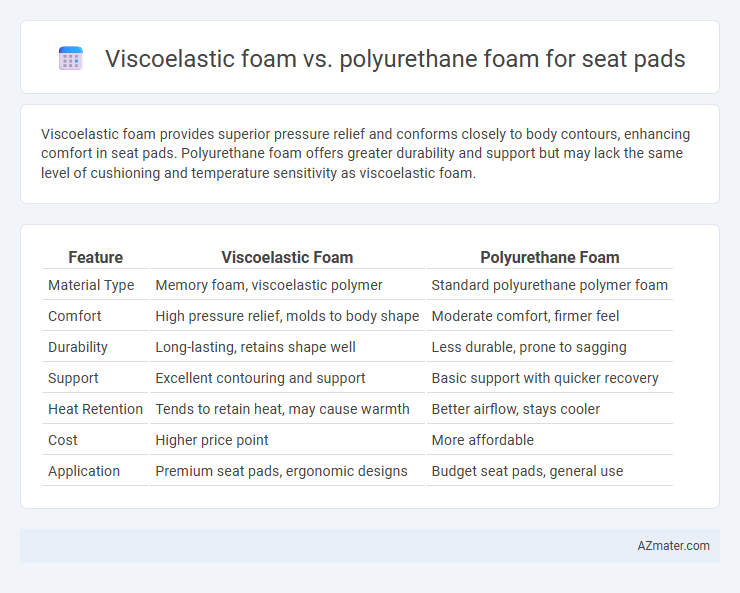Viscoelastic foam provides superior pressure relief and conforms closely to body contours, enhancing comfort in seat pads. Polyurethane foam offers greater durability and support but may lack the same level of cushioning and temperature sensitivity as viscoelastic foam.
Table of Comparison
| Feature | Viscoelastic Foam | Polyurethane Foam |
|---|---|---|
| Material Type | Memory foam, viscoelastic polymer | Standard polyurethane polymer foam |
| Comfort | High pressure relief, molds to body shape | Moderate comfort, firmer feel |
| Durability | Long-lasting, retains shape well | Less durable, prone to sagging |
| Support | Excellent contouring and support | Basic support with quicker recovery |
| Heat Retention | Tends to retain heat, may cause warmth | Better airflow, stays cooler |
| Cost | Higher price point | More affordable |
| Application | Premium seat pads, ergonomic designs | Budget seat pads, general use |
Introduction to Seat Pad Materials
Viscoelastic foam, known for its superior pressure distribution and memory foam properties, offers enhanced comfort and support in seat pads by conforming to body shape and reducing pressure points. Polyurethane foam, widely used for its durability and cushioning, provides a firmer seating experience with faster rebound but less contouring ability compared to viscoelastic foam. Selecting between viscoelastic and polyurethane foam depends on priorities such as comfort, support, and longevity in seat pad applications.
What is Viscoelastic Foam?
Viscoelastic foam, commonly known as memory foam, is a polyurethane-based material infused with additional chemicals to increase its viscosity and density, creating a slow-response effect when pressure and heat are applied. This foam adapts closely to the body's shape, providing enhanced support and pressure relief compared to traditional polyurethane foam, which is typically more elastic and less contouring. Its unique viscoelastic properties make it ideal for seat pads by offering superior comfort, reducing localized pressure points, and improving overall seating ergonomics.
What is Polyurethane Foam?
Polyurethane foam is a versatile seating material known for its durability and cost-effectiveness, characterized by an open-cell structure that offers good support and cushioning. It is manufactured through a chemical reaction between polyols and isocyanates, resulting in varying densities and firmness levels suitable for seat pads. Compared to viscoelastic foam, polyurethane foam provides quicker recovery and higher resilience but lacks the slow-response contouring and pressure-relief properties typical of memory foam.
Key Differences Between Viscoelastic and Polyurethane Foams
Viscoelastic foam, commonly known as memory foam, offers superior pressure relief and contouring by responding slowly to body heat and weight, making it ideal for seat pads requiring enhanced comfort and support. Polyurethane foam provides a more resilient and bouncy feel with faster recovery time, favoring durability and cost-effectiveness for high-traffic or budget-conscious seating solutions. Key differences include viscoelastic foam's slower response and higher density versus polyurethane foam's quick response and variable density options tailored to different firmness levels.
Comfort and Support Comparison
Viscoelastic foam seat pads provide superior comfort by contouring to body shape, offering excellent pressure relief and reducing discomfort during prolonged sitting. Polyurethane foam, while more resilient and durable, typically offers firmer support but less conforming comfort compared to viscoelastic alternatives. The viscoelastic foam's ability to absorb and distribute weight evenly makes it ideal for applications requiring enhanced ergonomic support and reduced fatigue.
Durability and Longevity
Viscoelastic foam offers superior durability and longevity compared to traditional polyurethane foam due to its ability to slowly regain shape under pressure, reducing wear and deformation over time. Polyurethane foam tends to compress and lose resilience faster, resulting in a shorter lifespan for seat pads exposed to frequent use. Investing in viscoelastic foam enhances seat pad performance by providing consistent support and maintaining comfort for extended periods.
Breathability and Temperature Regulation
Viscoelastic foam, known for its open-cell structure, offers moderate breathability by allowing some airflow, which aids in temperature regulation but can retain heat under prolonged use. Polyurethane foam generally features a denser composition with less air permeability, often resulting in reduced breathability and a warmer seating experience. Selecting seat pads with enhanced ventilation channels or gel-infused viscoelastic foam can significantly improve heat dissipation and user comfort in both materials.
Cost and Affordability
Viscoelastic foam generally costs more than polyurethane foam due to its advanced memory and pressure-relief properties, making it a premium choice for seat pads. Polyurethane foam offers greater affordability and is widely used for budget-conscious applications without sacrificing basic comfort. Cost-effectiveness depends on the specific seating requirements, with polyurethane foam providing a more economical solution while viscoelastic foam adds value through enhanced durability and comfort.
Best Applications for Each Foam Type
Viscoelastic foam, known for its superior pressure relief and contouring properties, is best suited for seat pads in medical and therapeutic applications where prolonged sitting requires enhanced comfort and support. Polyurethane foam excels in general seating applications such as office chairs and automotive seats due to its durability, resilience, and cost-effectiveness. Selecting the right foam depends on the balance between comfort, support, and intended usage duration.
Choosing the Right Foam for Your Seat Pad
Viscoelastic foam offers superior pressure relief and contouring by responding to body heat and weight, making it ideal for seat pads requiring enhanced comfort and support. Polyurethane foam provides higher durability and a firmer feel, suitable for applications needing structural stability and resilience over time. Selecting the right foam depends on prioritizing comfort and pressure distribution with viscoelastic foam or opting for cost-effective, long-lasting firmness with polyurethane foam.

Infographic: Viscoelastic foam vs Polyurethane foam for Seat pad
 azmater.com
azmater.com